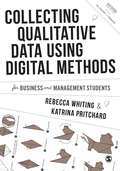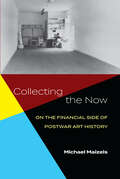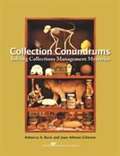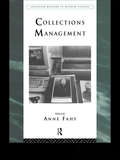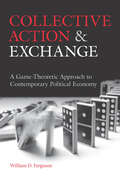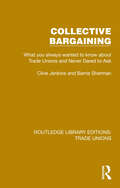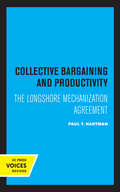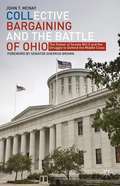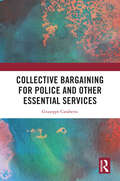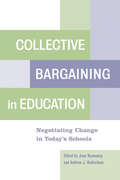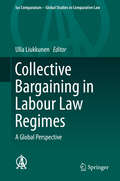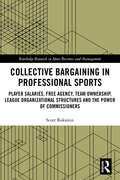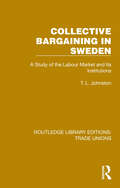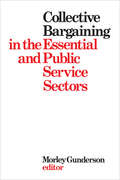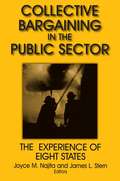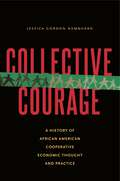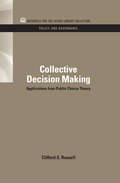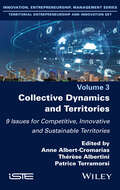- Table View
- List View
Collecting Qualitative Data Using Digital Methods (Mastering Business Research Methods)
by Katrina Pritchard Rebecca WhitingPart of SAGE’s Mastering Business Research Methods Series, conceived and edited by Bill Lee, Mark N. K. Saunders and Vadake K. Narayanan and designed to support researchers by providing in-depth and practical guidance on using a chosen method of data collection or analysis. In Collecting Qualitative Data Using Digital Methods, Rebecca Whiting and Katrina Pritchard provide a concise and accessible guide to a digital data collection method, comprised of tracking and trawling that can be used to collect qualitative data in the fields of business, management and organizational research. With practical guidance and insight into how to use this approach in your own research, this book provides invaluable support to Business and Management masters students who choose to work with secondary data when completing their dissertations.
Collecting Qualitative Data Using Digital Methods (Mastering Business Research Methods)
by Katrina Pritchard Rebecca WhitingPart of SAGE’s Mastering Business Research Methods Series, conceived and edited by Bill Lee, Mark N. K. Saunders and Vadake K. Narayanan and designed to support researchers by providing in-depth and practical guidance on using a chosen method of data collection or analysis. In Collecting Qualitative Data Using Digital Methods, Rebecca Whiting and Katrina Pritchard provide a concise and accessible guide to a digital data collection method, comprised of tracking and trawling that can be used to collect qualitative data in the fields of business, management and organizational research. With practical guidance and insight into how to use this approach in your own research, this book provides invaluable support to Business and Management masters students who choose to work with secondary data when completing their dissertations.
Collecting the Now: On the Financial Side of Postwar Art History
by Michael MaizelsCollecting the Now offers a new, in-depth look at the economic forces and institutional actors that have shaped the outlines of postwar art history, with a particular focus on American art, 1960–1990. Working through four case studies, Michael Maizels illuminates how a set of dealers and patrons conditioned the iconic developments of this period: the profusions of pop art, the quixotic impossibility of land art, the dissemination of new media, and the speculation-fueled neo-expressionist painting of the 1980s. This book addresses a question of pivotal importance to a swath of art history that has already received substantial scholarly investigation. We now have a clear, nuanced understanding of why certain evolutions took place: why pop artists exploded the delimited parameters of aesthetic modernism, why land artists further strove against the object form itself, and why artists returned to (neo-)traditional painting in the 1980s. But remarkably elided by extant scholarship has been the question of how. How did conditions coalesce around pop so that its artists entered into museum collections, and scholarly analyses, at pace unprecedented in the prior history of art? How, when seeking to transcend the delimited gallery object, were land artists able to create monumental (and by extension, monumentally expensive), interventions in the extreme wilds of the Western deserts? And how did the esoteric objects of media art come eventually to scholarly attention in the sustained absence of academic interest or a private market? The answers to these questions lie in an exploration of the financial conditions and funding mechanisms through which these works were created, advertised, distributed, and preserved.
Collecting, Managing, and Assessing Data Using Sample Surveys
by Peter StopherCollecting, Managing, and Assessing Data Using Sample Surveys provides a thorough, step-by-step guide to the design and implementation of surveys. Beginning with a primer on basic statistics, the first half of the book takes readers on a comprehensive tour through the basics of survey design. Topics covered include the ethics of surveys, the design of survey procedures, the design of the survey instrument, how to write questions and how to draw representative samples. Having shown readers how to design surveys, the second half of the book discusses a number of issues surrounding their implementation, including repetitive surveys, the economics of surveys, web-based surveys, coding and data entry, data expansion and weighting, the issue of non-response, and the documenting and archiving of survey data. The book is an excellent introduction to the use of surveys for graduate students as well as a useful reference work for scholars and professionals.
Collection Conundrums: Solving Collections Management Mysteries
by Rebecca A. Buck Jean Allman GilmoreCollection Conundrums provides guidelines for investigating and determining what to do with the oddities found in every museum collection -- objects without record, identification or sometimes even a location. Written by registrars Rebecca Buck and Jean A. Gilmore, editors of the best-selling Museum Registration Methods 5th Edition, this volume contains essential information for museums large and small, new and old. The text features a history of registration methods and the standards for collection documentation and care, along with sample documents such as loan agreements, co-tenancy agreements, storage agreements, and deed of gift. Essential reading for everyone involved in collections planning and management.
Collections Management
by Anne FahyCollections Management brings together leading papers exploring some of the major issues affecting collections management. Providing information about initiatives and issues for anyone involved in collections management, Fahy identifies the main issues relating to collecting and disposal of collections and discusses why museums should develop appropriate documentation systems. Examining the status of research within museums, the various sources of advice relating to security and addresses the basics of insurance and indemnity, Collections Management is an invaluable and very practical introduction to this topic for students of museum studies and museum professionals.
Collective Action and Exchange: A Game-Theoretic Approach to Contemporary Political Economy
by William D. FergusonIn Collective Action and Exchange: A Game-Theoretic Approach to Contemporary Political Economy, William D. Ferguson presents a comprehensive political economy text aimed at advanced undergraduates in economics and graduate students in the social sciences. The text utilizes collective action as a unifying concept, arguing that collective-action problems lie at the foundation of market success, market failure, economic development, and the motivations for policy. Ferguson draws on information economics, social preference theory, cognition theory, institutional economics, as well as political and policy theory to develop this approach. The text uses classical, evolutionary, and epistemic game theory, along with basic social network analysis, as modeling frameworks. These models effectively bind the ideas presented, generating a coherent theoretic approach to political economy that stresses sometimes overlooked implications.
Collective Action!: The Power of Collaboration and Co-Design in Architecture
by Kyle Buchanan Rob Fiehn Mellis HawardBuildings cannot be built without people working together. Architects collaborate with other disciplines, other architects and even with the public. These take place every day, across multiple planning and design stages. Small or emerging practices often suffer from a lack of resources, but what if we pooled our collective resources, sharing knowledge and experiences? Collaborative architecture begins in the design studio, and the relationship between academia and practice can create a symbiosis that is fundamental to the careers of young and more established architects. It provides a space to develop and test approaches outside of routine commercial pressures, using research to yield new approaches that further the impact of the architecture sector more widely. By cooperating, we can facilitate a good design process can lay the foundation for a better form of architecture that provides greater diversity and a plurality of voices. This volume showcases how practices have the potential to adapt, remain resilient and harness collective power to become greater than the sum of their parts. The future is bright for architects if they can unite. Take Collective Action! Features: Sarah Ahmed, Marc Cairns, Alasdair Ben Dixon, Amy Francis-Smith, Lanre Gbolade, Stephen Hill, Khuzema Hussain, Lacol, Matthew Morris, Chris Nasah, David Ogunmuyiwa, POoR Collective, Retrouvius, Dhruv Adam Sookhoo, Samuel Stair, Tomas Tvarijonas, Dr Joe Jack Williams, WIP Collaborative and Siri Zanelli.
Collective Actions of Solidarity against Food Insecurity: The impact in terms of Capabilities (RaumFragen: Stadt – Region – Landschaft)
by Daniela BernaschiThis book analyzes the issue of food insecurity in Europe. It highlights the role played by cities in promoting resilient, solidarity-based and food and nutritionally safe communities. The focus will be on three different local initiatives in Rome, Barcelona and Athens and on the relations between civil society and local public institutions in order to tackle with the food insecurity challenges. The research is aimed at understanding the paradox of food insecurity in wealthy societies. The focus will be on three European countries: Italy, Spain and Greece. An in-depth analysis on collective actions of solidarity to tackle food insecurity, will assess whether the initiatives are capabilities-oriented or merely compensating for shortcomings. Moreover, the contributions to the definition of a new food policy “by” and “for” the cities will be highlighted.
Collective Bargaining (Routledge Library Editions: Trade Unions #11)
by Clive Jenkins Barrie ShermanOriginally published in 1977, this book explains the complexity of collective bargaining and discusses the nature of trade unionism and trade unions, emphasising the collectivity aspect. It discusses a union’s work at local and national levels, when dealing with an employers’ federation, and with various types of employers. Among the topics covered are the legal processes involved in collective bargaining, the topics about which collective bargaining takes place (recognition, the salary package, pensions, for example, and the back-up services necessary to conduct effective bargaining and industrial action.
Collective Bargaining and Productivity: The Longshore Mechanization Agreement
by Paul T. HartmanThis title is part of UC Press's Voices Revived program, which commemorates University of California Press’s mission to seek out and cultivate the brightest minds and give them voice, reach, and impact. Drawing on a backlist dating to 1893, Voices Revived makes high-quality, peer-reviewed scholarship accessible once again using print-on-demand technology. This title was originally published in 1969.
Collective Bargaining and the Battle of Ohio
by John T. McnayThe story of how the Ohio conference of the American Association of University Professors mobilized its resources and fought alongside Teamsters, firefighters, janitors, and police to defeat Ohio Senate Bill 5 by referendum, restoring collective bargain rights across the state.
Collective Bargaining for Police and Other Essential Services
by Giuseppe CarabettaThis book examines how collective bargaining disputes are resolved among police and essential service employees.In Australia, as in other common law countries, police and other highly essential employees such as fire-fighters and ambulance officers have long had access to a form of binding arbitration to settle collective bargaining disputes. The traditional arbitration-based system in Australia has, however, been replaced in recent decades with a marked-based collective bargaining system. The current (Fair Work) system restricts access to arbitration, favouring collective bargaining based on the parties’ prerogative to make their own agreements, and supported by a limited right to industrial action — including strikes — during bargaining. Yet, police officers, particularly, are subject to considerable restraints on any entitlement to participate in industrial action. The problem is that with limited access to arbitration, and an especially limited right to industrial action, intractable disputes may continue indefinitely, without any impasse-breaking process to prevent the flow-on harms of long-running police disputes. This raises the essential question underpinning this study: what form of dispute resolution system is appropriate to protect both the legitimate industrial interests of police officers, and the community’s interest in the uninterrupted provision of essential policing services?The author in his extensive field-work research and his study of international case studies has developed a useful model for mandatory interest arbitration among police and other essential services personnel. The lessons and recommendations in the book offer insights for essential services labour law in Australia and overseas.
Collective Bargaining in Education: Negotiating Change in Today's Schools
by Jane Hannaway and Andrew J. RotherhamThis timely and comprehensive volume will spur and strengthen public debate over the role of teachers unions in education reform for years to come. Collective bargaining shapes the way public schools are organized, financed, staffed, and operated. Understanding collective bargaining in education and its impact on the day-to-day life of schools is critical to designing and implementing reforms that will successfully raise student achievement. But when it comes to public discussion of school reform, teachers unions are the proverbial elephant in the room. Despite the tremendous influence of teachers unions, there has not been a significant research-based book examining the role of collective bargaining in education in more than two decades. As a result, there is little basis for a constructive, empirically grounded dialogue about the role of teachers unions in education today.
Collective Bargaining in Labour Law Regimes: A Global Perspective (Ius Comparatum - Global Studies in Comparative Law #32)
by Ulla LiukkunenThis book addresses the theme of collective bargaining in different legal systems and explores legal framework of collective bargaining as well as the role of different bargaining models in domestic labour law systems in altogether twenty-one jurisdictions throughout the world. Recent development of collective bargaining regimes can be viewed as part of a larger development of labour law models that face increasing challenges caused by globalization and transition of work and workplaces. The book places particular emphasis on identifying and examining most important development trends affecting domestic labour law regimes and collective bargaining and regulatory responses thereto. The analysis offered extents to transnational dimension of collective bargaining. As the chapters analyse the influence of the legal frameworks of collective bargaining in different countries they provide unique comparative insight into the topic which is central to understanding the function of labour law.
Collective Bargaining in Professional Sports: Player Salaries, Free Agency, Team Ownership, League Organizational Structures and the Power of Commissioners (Routledge Research in Sport Business and Management)
by Scott BuksteinCollective Bargaining in Professional Sports provides a timely and practical overview of the impact and importance of the collective bargaining process in the business of professional sports in the United States. Focusing on the contemporary history of collective bargaining in the National Basketball Association (NBA) and the National Football League (NFL), but drawing out important lessons for all professional sports, the book sheds light on some of the key issues within modern sport business and sport governance. It offers an inside look into topics such as revenue sharing, competitive balance, circumvention of league rules, player free agency, player social activism, player discipline, and the ethical and legal issues around the use of wearable biometric tracking systems to collect player data. An essential read for sports business industry practitioners and students alike, this is fascinating reading for anybody with an interest in sport business, sport law or labor relations. It is also a valuable resource for anyone who wants to increase their understanding of the business and financial operations of professional sports leagues and teams, player contracts and salaries, and the role and authority of professional sports league commissioners.
Collective Bargaining in Sweden: A Study of the Labour Market and Its Institutions (Routledge Library Editions: Trade Unions #13)
by T. L. JohnstonOriginally published in 1962, this book analyses and assesses the Swedish Government and structure of both trade unions and employers’ organizations, including the spread of unionism to white-collar workers. It then examines Swedish labour legislation, which established an act on Collective Contracts, a Labour Court and a mediation service. The book also shows the collective bargaining system at work under conditions of full employment, and examines critically the attempts to develop a policy for wages through the labour market organizations, rather than by government decree. Anyone, in mature or developing economies, concerned with collective bargaining and wage policies will find this lucid study of the Swedish system a rich source book for positive policies.
Collective Bargaining in the Essential and Public Service Sectors: Proceedings of a conference held on 3 and 4 April 1975, organized by David Beatty through the Centre for Industrial Relations University of Toronto, chaired by John Crispo
by Morley GundersonIn Toronto, in April 1975, three Canadians and one American each presented a paper at a conference on what has become the key issue in current industrial relations – collective bargaining in the essential and public service sectors. This book presents those papers along with transcripts of the substantial and lively discussions that followed each one and involved many of the leading Canadian figures in this field. The status of government employees is one of the most prominent of the issues discussed. The speakers, Ben Aaron, University of California, Jean Boivin, Université Laval, James Matkin, Government of British Columbia, and Paul Phillips, University of Manitoba, deal with the causes of unrest in the essential and service sectors of the economy, the interrelationship of market and political forces, the results of various forms of government intervention, and also with international comparison of procedures for dispute settlement. There was a considerable diversity of opinion expressed, yet there emerged from the discussions a sense of agreement as to which policies should be followed and those that definitely should not. The debate on collective bargaining in the essential and public sectors is current in legislatures and elsewhere. This work will be helpful in advancing that debate and in encouraging the adoption of measures conducive to social harmony. It will interest students of industrial relations, all those involved in public and essential service negotiations and legislation, and members of the general public affected by the disputes and interested in their resolution. The conference was organized by David Beatty and chaired by John Crispoo, and the papers edited by Morley Gunderson, all of the University of Toronto.
Collective Bargaining in the Public Sector: The Experience of Eight States (Issues In Work And Human Resources Ser.)
by Joyce M. Najita James L. SternUnlike Europe, where most public sector workers have long been included in collective bargaining agreements, the United States excluded public employees from such legislation until the 1960s and 70s. Since then, union membership in the U. S. has grown more rapidly among public workers than among workers in the private sector. This book provides up-to-date information on public sector collective bargaining in the United States today. The editors' seek to understand the real nature of PSB by examining eight states where the action is taking place -- California, Hawaii, Illinois, Michigan, New Jersey, New York, Pennsylvania, and Wisconsin. The chapters offer unique case studies of legal origins, developments, and challenges to collective bargaining; negotiations experience and outcomes; discussion of legislation; and emphasis of histoical development as well as current practice.
Collective Bargaining: Perspectives and Practices
by B. R. PatelAfter a careful research, and a full exchange of views with the union bargaining agents for weeks before an offer is made, the company puts what it believes proper on the table and changes it only on the basis of what is considered 'new information'.
Collective Courage: A History of African American Cooperative Economic Thought and Practice
by Jessica Gordon NembhardIn Collective Courage, Jessica Gordon Nembhard chronicles African American cooperative business ownership and its place in the movements for Black civil rights and economic equality. Not since W. E. B. Du Bois’s 1907 Economic Co-operation Among Negro Americans has there been a full-length, nationwide study of African American cooperatives. Collective Courage extends that story into the twenty-first century. Many of the players are well known in the history of the African American experience: Du Bois, A. Philip Randolph and the Ladies' Auxiliary to the Brotherhood of Sleeping Car Porters, Nannie Helen Burroughs, Fannie Lou Hamer, Ella Jo Baker, George Schuyler and the Young Negroes’ Co-operative League, the Nation of Islam, and the Black Panther Party. Adding the cooperative movement to Black history results in a retelling of the African American experience, with an increased understanding of African American collective economic agency and grassroots economic organizing. To tell the story, Gordon Nembhard uses a variety of newspapers, period magazines, and journals; co-ops’ articles of incorporation, minutes from annual meetings, newsletters, budgets, and income statements; and scholarly books, memoirs, and biographies. These sources reveal the achievements and challenges of Black co-ops, collective economic action, and social entrepreneurship. Gordon Nembhard finds that African Americans, as well as other people of color and low-income people, have benefitted greatly from cooperative ownership and democratic economic participation throughout the nation’s history.
Collective Courage: A History of African American Cooperative Economic Thought and Practice (G - Reference, Information and Interdisciplinary Subjects)
by Jessica Gordon NembhardIn Collective Courage, Jessica Gordon Nembhard chronicles African American cooperative business ownership and its place in the movements for Black civil rights and economic equality. Not since W. E. B. Du Bois’s 1907 Economic Co-operation Among Negro Americans has there been a full-length, nationwide study of African American cooperatives. Collective Courage extends that story into the twenty-first century. Many of the players are well known in the history of the African American experience: Du Bois, A. Philip Randolph and the Ladies' Auxiliary to the Brotherhood of Sleeping Car Porters, Nannie Helen Burroughs, Fannie Lou Hamer, Ella Jo Baker, George Schuyler and the Young Negroes’ Co-operative League, the Nation of Islam, and the Black Panther Party. Adding the cooperative movement to Black history results in a retelling of the African American experience, with an increased understanding of African American collective economic agency and grassroots economic organizing. To tell the story, Gordon Nembhard uses a variety of newspapers, period magazines, and journals; co-ops’ articles of incorporation, minutes from annual meetings, newsletters, budgets, and income statements; and scholarly books, memoirs, and biographies. These sources reveal the achievements and challenges of Black co-ops, collective economic action, and social entrepreneurship. Gordon Nembhard finds that African Americans, as well as other people of color and low-income people, have benefitted greatly from cooperative ownership and democratic economic participation throughout the nation’s history.
Collective Decision Making: Applications from Public Choice Theory (RFF Policy and Governance Set)
by Clifford S. RussellFirst Published in 2011.This is Volume 11 of fourteen in the library collection of Policy and Government and looks at the applications from public choice theory on decision making. It brings together proceedings that look seek to answer the question for the forum, which was whether public choice theory offers promise of providing a firmer foundation for applied institutional research and for institutional innovations which could contribute to the solution of some of these problems.
Collective Dynamics and Territories: 9 Issues for Competitive, Innovative and Sustainable Territories
by Anne Albert-Cromarias Patrice Terramorsi Thérèse AlbertiniFaced with global economic, social and environmental challenges requiring us to go beyond individual actions, the development of collective dynamics is the ideal response. From this perspective, territories, which have long been neglected, are now asserting themselves as breeding grounds for innovative and relevant forms of organized action in response to shared experiences. Bringing together more than twenty researchers in strategic management, human resources management and marketing, Collective Dynamics and Territories offers, through nine territorial issues (innovating and regenerating territories, building environmental action, attracting and retaining talent, etc.), insights into the conditions and modalities for developing collective dynamics within territories. The success of local collective dynamics depends on support for the actors involved, from situation analysis to problem definition, including idea generation, selection, implementation and evaluation. This book offers a comprehensive, systemic and operational vision for analyzing and acting on collective territorial dynamics.
